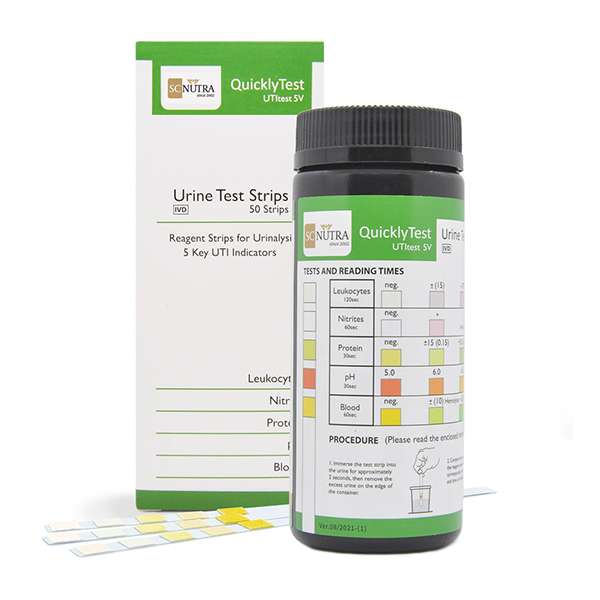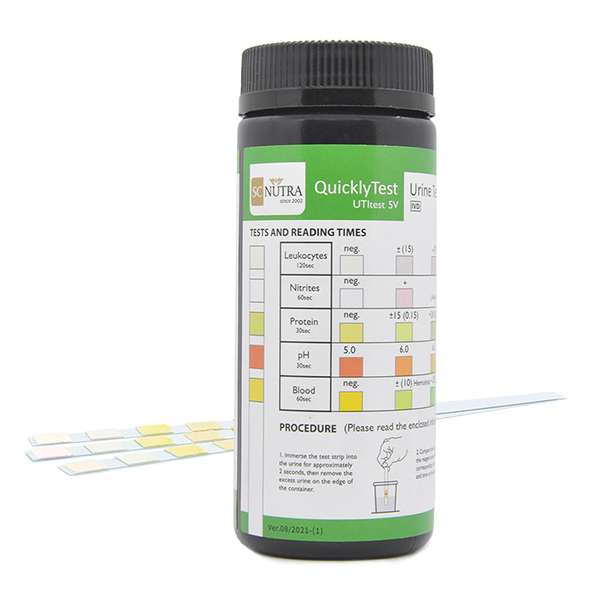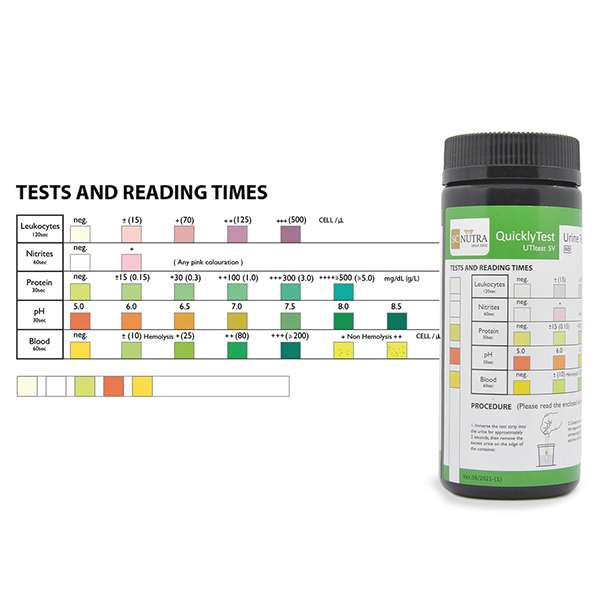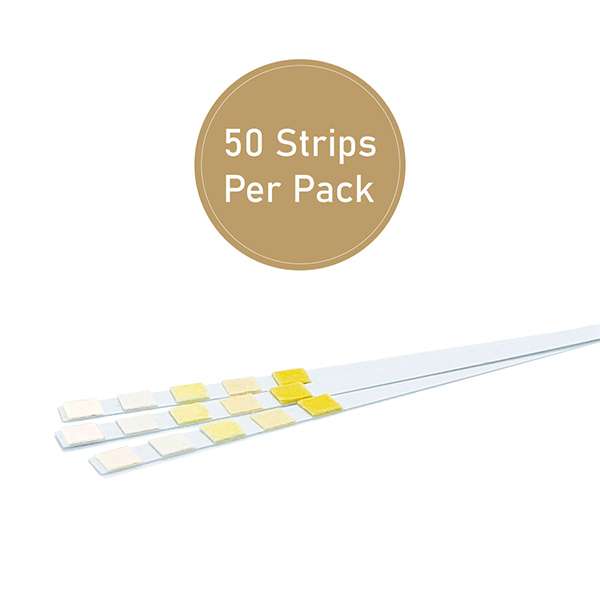SC Nutra
Bandelettes SC Nutra pour test urinaire
4.94 / 5.0
(33) 33 total des critiques
Free delivery from 99€ per order in France.
Impossible de charger la disponibilité du service de retrait
Introduction
Les bandelettes test d’urine SC Nutra sont d’utilisation rapide et facile pour détecter 5 éléments principaux (leucocytes, nitrites, protéines, pH, sang) et savoir précisément ce qu’il se passe dans vos urines. Vous pouvez gérer leur pH, y vérifier la présence de nitrites ou d’une infection, et en surveiller l’évolution. Nous y joignons une fiche d’information mais vous conseillons de consulter votre médecin ou un urologue pour interpréter les résultats.
How to use the urine test strips
UTItest 5V is suitable not only for health professionals who perform tests, but also for individuals. We therefore include a very simple guide for people who have no technical knowledge, as well as a complete medical information brochure for professionals who master the technical details.
Specific instructions are included in the box
The test strips quickly and easily indicate the infection status of your urine. Consult your doctor or urologist for a detailed interpretation of your results.
- Urinate into a clean container.
- Take out a test strip and seal the box immediately. Dip the strip into the urine for 2 seconds. Tap the side of the strip on the edge of the container to remove excess urine. If the excess urine passes from one urine reagent to the other on the strip, the results will be incorrect.
- Look at the reagent strips on the test strip. The first thing to check (after 20-30 seconds) is the pH, on the2nd strip from the bottom.
a/ If the reagent has turned orange, the urine is too acidic.
b/ If it has turned dark green, the urine is too alkaline.
You can balance your urinary pH through your diet. Consult a dietician.
- Check for protein (middle). A turquoise green shade indicates the presence of protein. The darker the shade, the more protein. This usually means that your kidneys have an infection. Check with your doctor.
- Check the red blood cells. A green color indicates the presence of blood. If the reagent turns dark green within 60 seconds, the amount of blood in your urine is significant. There can be many reasons for this, so don't be overly concerned and see your doctor.
- Check for nitrite (2nd band from the top). Nitrates are broken down into nitrites by bacteria, so a pink color indicates the presence of bacteria in your urine.
- Check the last reagent (top) for leukocytes (white blood cells). A pink colouration within 2 minutes indicates the presence of inflammation and possibly bacteria.
The more pronounced the staining becomes within the time period indicated, the more certain it is that bacteria are present and the more concentrated they are. To have your urine analyzed for detailed information on the bacterial strain and possible kidney damage, or for a better interpretation of the test results, consult your doctor or a specialist.
Other issues to consider
While monitoring the quality of your urine is important for interpreting your progress, it is not sufficient. UTItest 5V can tell you with a high degree of reliability if you still have a UTI, but it cannot define the bacterial strain involved. If natural remedies are unable to cure the infection, have a competent laboratory perform a culture from your urine to identify the infectious agents.
The benefits of urine testing
- A simple home test. Boxes of 50 strips allow repeated testing over a long period of time.
- A quick check of the pH of your urine. A pH of 7.5 to 8 (alkaline) in most cases contributes to slow bacterial growth and helps prevent infections. Our grandmothers knew this and used to drink orgeat with lemon juice to promote an alkaline environment that was unfriendly to most bacteria that cause urinary tract infections.
- Checking for blood cells, protein and nitrite. The presence of red and white blood cells indicates inflammation or infection. Protein indicates a possible kidney infection. Normally, nitrites are only detected in the urine when bacteria are present.
- The guarantee of a good medical reliability.
- Simple instructions for home use.
- A diagnostic aid that has been appreciated by Sweet Cures customers for years. We have sold thousands of test kits and have always had excellent feedback on their effectiveness and ease of use compared to other brands.
- The shipment is usually received the next day.
- The help of a very efficient customer service, with ten years of experience.
Principles and limitations of urine testing
Leukocytes:
The test reveals the presence of glanulocyte esterases. These esterases cleave an indoxyl ester, and the released indoxyl reacts with a diazonium salt to produce a purple dye.
The resulting leukocyte esterase may be positive in the absence of observable cells if the leukocytes have lysed. Positive results can sometimes be found in random urine samples from women. This is due to contamination of these samples with vaginal discharge. High glucose concentrations (55-110 mmol/l) or high specific gravity may decrease the intensity of the result. The presence of cephalexin, cefalotin or tetracycline may cause a decrease in reactivity, and high levels of these drugs may cause a false negative reaction. The reactive zone does not react with lymphocytes.
Nitrites:
The test is based on the principle of the Griess test, specific for nitrite. All degrees of uniform pink should be interpreted as positive.
Positive test results suggest the presence of 105 (100,000) or more organisms per ml of urine, but the color development is not proportional to the number of bacteria present. A negative result does not in itself prove that there is no significant bacteriuria. Negative results may occur when urinary tract infections are caused by organisms that do not contain a reductase to convert nitrate to nitrite; when urine has not been retained long enough in the bladder (4-8 hours) for nitrate reduction to occur; or when nitrate is absent from the diet, even if organisms containing the reductase are present and incubation in the bladder is sufficient. Ascorbic acid concentrations at 2.8 mmol/l or higher may cause false negative results in samples containing a nitrite ion concentration of 35 μmol/l or less.
Protein :
The test is based on the protein error principle of pH indicators.
The test area is sensitive to albumin. High pH (above 9) may affect the test. Residues of disinfectant containing quaternary ammonium groups or chlorhexidine in the urine collection vessel may cause a false positive result.
pH:
This test contains a mixed indicator that causes a marked color change between pH 5 and pH 8.5. It may be necessary to repeat the test several times at 3-hour intervals to determine the dominant pH. High or low pH, or abrupt changes in pH may indicate the presence of bacteriuria.
Blood:
Hemoglobin and myoglobin catalyze the oxidation of the indicator with the organic hydroperoxide contained in the test strip.
This test is very sensitive to hemoglobin and can complement microscopic examination. The sensitivity of this test may be reduced in high specific gravity (highly concentrated) urine. The test is also sensitive to myoglobin and hemoglobin (a hemoglobin concentration of 150-620 μg/l is roughly equivalent to 5-15 intact red blood cells per microliter). Captopril and iodine can also lower reactivity. Blood is often found in the urine of menstruating women. Certain oxidizing contaminants such as hypochlorite may promote false positive results. The presence of microbial peroxidase associated with a urinary tract infection can also cause a false positive result. Ascorbic acid concentrations of 2 mmol/L or more can cause false negative results in trace amounts.
Values and scope
The values depend on the presence or absence of interfering samples.
Tests Reference values Perimeter
Leukocytes Granulocytes: 15-40 /μl Negative - 500 cel./μl
Nitrite 13-22 μmol/l Negative - positive
Protein Albumin: 0.10-0.15 g/l Negative - 5 g/l
pH Unit: 0.5 pH pH from 5 to 8.5
Blood Hemoglobin: 0.15-0.60 mg/l Negative - 200 cel./μl
Composition of the reagents
Based on the dry weight content of each reagent per 100 strips:
Leukocytes: 1.4 mg indoxyl ester, 0.7 mg diazonium salt
Nitrite: 0.65 mg of sulfanilamide, 0.45 mg of Naphthylethylenediamine dihydrochloride
Protein: 0.36 mg of tetrabromophenol blue
pH: 0.06 mg of methyl red and 1.3 mg of bromothymol blue
Blood: 35.2 mg cumene hydroperoxide, 3,3', 5,5' and 15 mg tetramethylbenzidine
Precautions
- Handling: Use a clean container to collect urine. For blood, false positive readings may result from residual strongly oxidizing disinfectants in the sample collection container. Do not add preservatives to the urine to be tested.
- Operation: Incorrect results may be obtained when stirring the strip in the container. Dip for about 2 seconds. If the dipping time is too short or too long, the result may not be interpretable.
Sample collection and preparation
Collect the urine in a container and proceed with the test as soon as possible. Do not centrifuge. The use of urine preservatives is not recommended. If the test cannot be performed within one hour of urination, refrigerate the sample immediately. Allow the sample to come to room temperature before testing.
Test procedure
- Take a strip from the bottle and close the cap tightly.
- Immerse all reagent areas of the strip in fresh, well-mixed urine. Remove the strip immediately to prevent the reagents from dissolving in the urine.
- As you remove it, tap the side of the strip on the edge of the container to remove excess urine. Dry its profile on a paper towel. Avoid rubbing the surface of the strip (risk of contamination of the reagents between them).
- Compare each reagent area to the corresponding color blocks on the color chart and read them, within the time frame indicated. Timely reading is essential for good results.
- Visualize your results by direct comparison with the colors of the map.
NOTE: All reagent zones will be read within 1 to 2 minutes to distinguish a positive sample from a negative sample. Color changes after 2 minutes have no diagnostic value.
Quality control
For good results, the performance of the test strips should be confirmed by comparison with known negative and positive samples or controls. This procedure is recommended after 25 strip uses and at each box and lot change. Users and laboratories should establish their own standards for performance standards.
Results
The results are obtained by direct comparison with the colors on the card printed on the container label. The color chart shows the nominal values. Actual values will vary around the nominal values.
Handling
Improper storage may decrease the performance of the test strips. Allow them to come to room temperature before use. Do not use deteriorated, discolored or blackened test strips. Avoid contamination with volatile chemicals. Do not touch the test strip papers.
To be noted
In principle, diagnosis or treatment is not based solely on the result of a single test, but must be established in the context of all other medical elements. Knowledge of the effect of drugs or their metabolites on individual tests is not yet complete. If in doubt, it is best to repeat the test after a given drug is discontinued. Large amounts of ascorbic acid in the urine can artificially produce false negative results, lower or higher, for the presence of blood or nitrite in the urine.
Conservation
Store the strips at 3-30°C, away from moisture, direct light and heat. Keep them in their original bottle. Leave the desiccants in the bottle. Do not remove a strip from the bottle unless you are using it immediately. Recap tightly and immediately after collecting the test strip. Unused strips from a closed vial must be used within 3 months. Do not use test strips after the expiration date printed on the label.
On the blog
Lire les articles à propos des Bandelettes SC Nutra pour test urinaire.
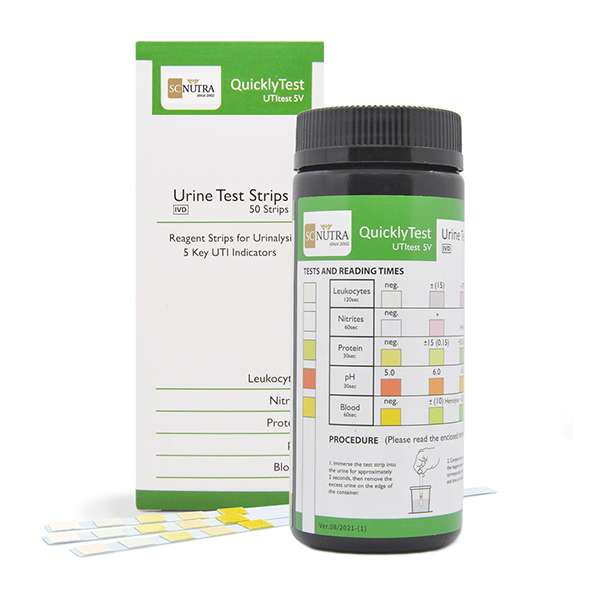
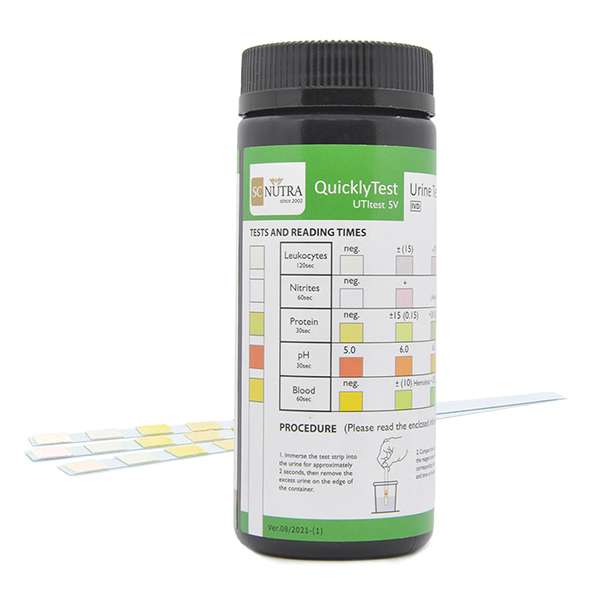
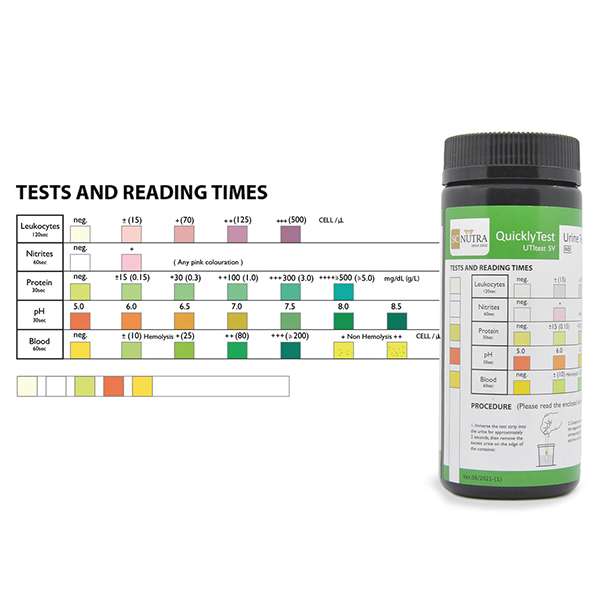
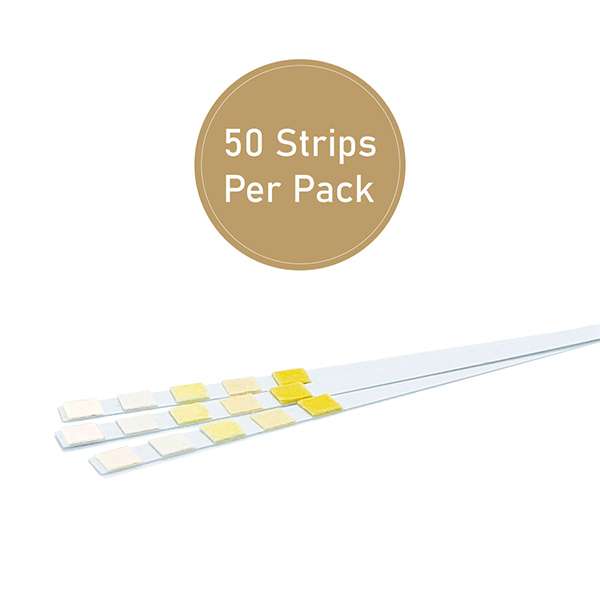
Utilisation facile, permet d'indiquer si vous avez vraiment besoin de consulter.
Bonjour,
Très bon produit.
Pratique , très facile d'utilisation.
Bon produit avec de bons résultats
Achetés pour connaître le PH, les résultats sont bien clairs
Produit qui tient ses promesses, information claire.
Hello ,
Too bad the instructions are not in French.
I have to consult my computer (your site).
So I haven't done the test yet.
I hope to see you soon.
Gisèle Collet.
Reviews in Other Languages
bon produit

